Consistency of Preferential Trade Agreements with GATT: A Critical Evaluation
VerifiedAdded on 2023/06/13
|14
|4018
|334
AI Summary
The essay evaluates the consistency of Preferential Trade Agreements (PTAs) with the General Agreement on Tariffs and Trade (GATT) and the success of WTO in ensuring such consistency. It discusses the rules and provisions of GATT/WTO related to PTAs, the issues and gaps in the framework, and the role of dispute settlement in enforcing the rules. The essay also highlights the rapid incline in PTAs and their impact on the global trading system.
Contribute Materials
Your contribution can guide someone’s learning journey. Share your
documents today.
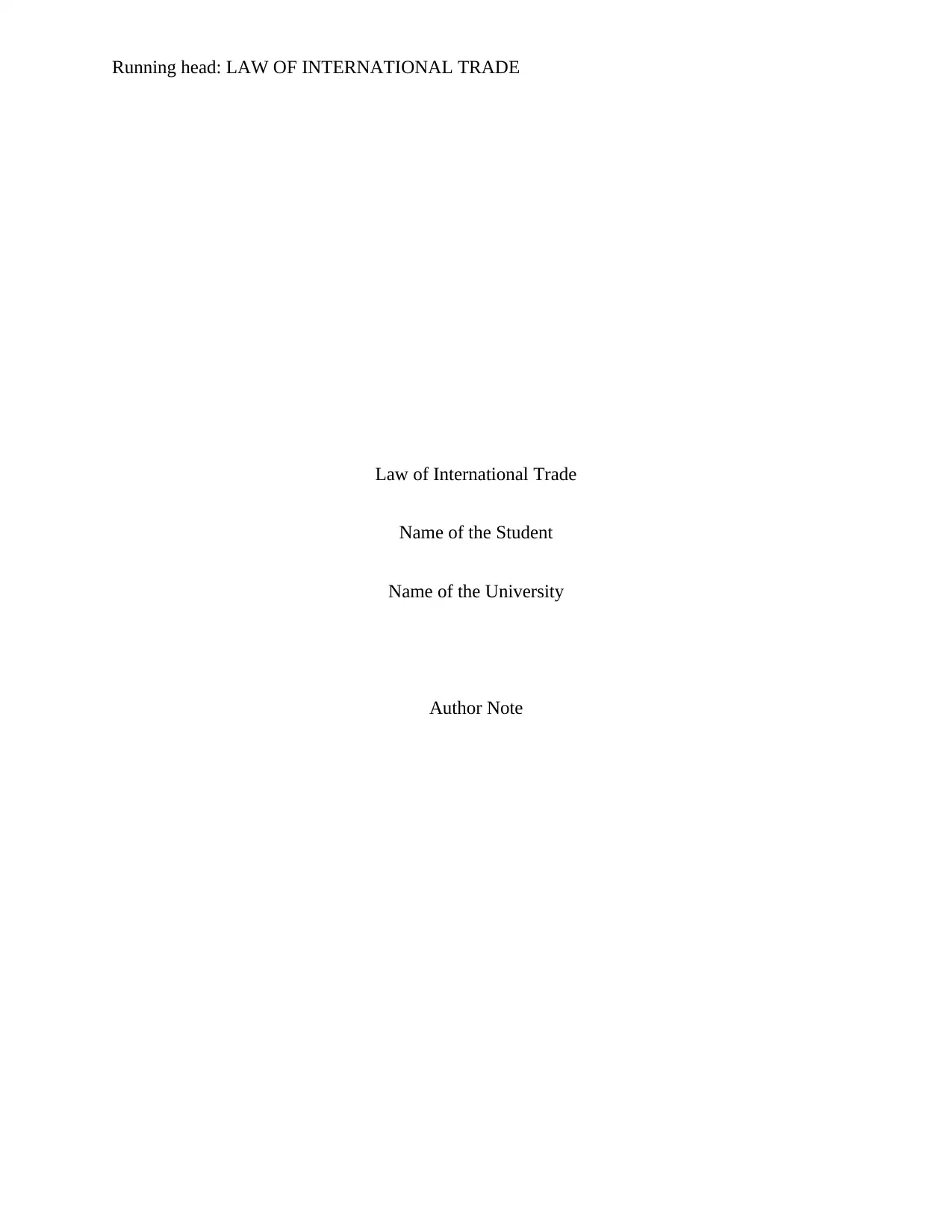
Running head: LAW OF INTERNATIONAL TRADE
Law of International Trade
Name of the Student
Name of the University
Author Note
Law of International Trade
Name of the Student
Name of the University
Author Note
Secure Best Marks with AI Grader
Need help grading? Try our AI Grader for instant feedback on your assignments.
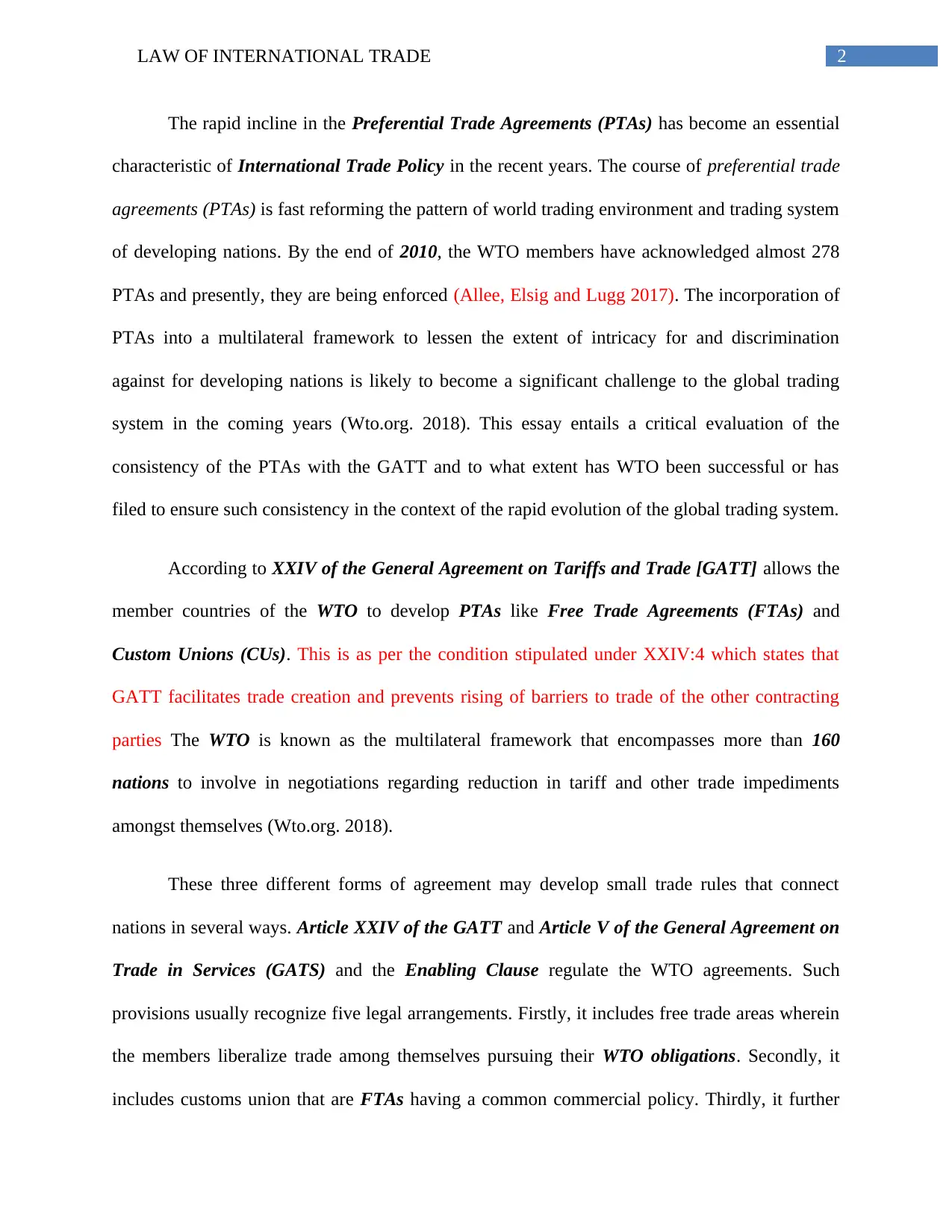
2LAW OF INTERNATIONAL TRADE
The rapid incline in the Preferential Trade Agreements (PTAs) has become an essential
characteristic of International Trade Policy in the recent years. The course of preferential trade
agreements (PTAs) is fast reforming the pattern of world trading environment and trading system
of developing nations. By the end of 2010, the WTO members have acknowledged almost 278
PTAs and presently, they are being enforced (Allee, Elsig and Lugg 2017). The incorporation of
PTAs into a multilateral framework to lessen the extent of intricacy for and discrimination
against for developing nations is likely to become a significant challenge to the global trading
system in the coming years (Wto.org. 2018). This essay entails a critical evaluation of the
consistency of the PTAs with the GATT and to what extent has WTO been successful or has
filed to ensure such consistency in the context of the rapid evolution of the global trading system.
According to XXIV of the General Agreement on Tariffs and Trade [GATT] allows the
member countries of the WTO to develop PTAs like Free Trade Agreements (FTAs) and
Custom Unions (CUs). This is as per the condition stipulated under XXIV:4 which states that
GATT facilitates trade creation and prevents rising of barriers to trade of the other contracting
parties The WTO is known as the multilateral framework that encompasses more than 160
nations to involve in negotiations regarding reduction in tariff and other trade impediments
amongst themselves (Wto.org. 2018).
These three different forms of agreement may develop small trade rules that connect
nations in several ways. Article XXIV of the GATT and Article V of the General Agreement on
Trade in Services (GATS) and the Enabling Clause regulate the WTO agreements. Such
provisions usually recognize five legal arrangements. Firstly, it includes free trade areas wherein
the members liberalize trade among themselves pursuing their WTO obligations. Secondly, it
includes customs union that are FTAs having a common commercial policy. Thirdly, it further
The rapid incline in the Preferential Trade Agreements (PTAs) has become an essential
characteristic of International Trade Policy in the recent years. The course of preferential trade
agreements (PTAs) is fast reforming the pattern of world trading environment and trading system
of developing nations. By the end of 2010, the WTO members have acknowledged almost 278
PTAs and presently, they are being enforced (Allee, Elsig and Lugg 2017). The incorporation of
PTAs into a multilateral framework to lessen the extent of intricacy for and discrimination
against for developing nations is likely to become a significant challenge to the global trading
system in the coming years (Wto.org. 2018). This essay entails a critical evaluation of the
consistency of the PTAs with the GATT and to what extent has WTO been successful or has
filed to ensure such consistency in the context of the rapid evolution of the global trading system.
According to XXIV of the General Agreement on Tariffs and Trade [GATT] allows the
member countries of the WTO to develop PTAs like Free Trade Agreements (FTAs) and
Custom Unions (CUs). This is as per the condition stipulated under XXIV:4 which states that
GATT facilitates trade creation and prevents rising of barriers to trade of the other contracting
parties The WTO is known as the multilateral framework that encompasses more than 160
nations to involve in negotiations regarding reduction in tariff and other trade impediments
amongst themselves (Wto.org. 2018).
These three different forms of agreement may develop small trade rules that connect
nations in several ways. Article XXIV of the GATT and Article V of the General Agreement on
Trade in Services (GATS) and the Enabling Clause regulate the WTO agreements. Such
provisions usually recognize five legal arrangements. Firstly, it includes free trade areas wherein
the members liberalize trade among themselves pursuing their WTO obligations. Secondly, it
includes customs union that are FTAs having a common commercial policy. Thirdly, it further
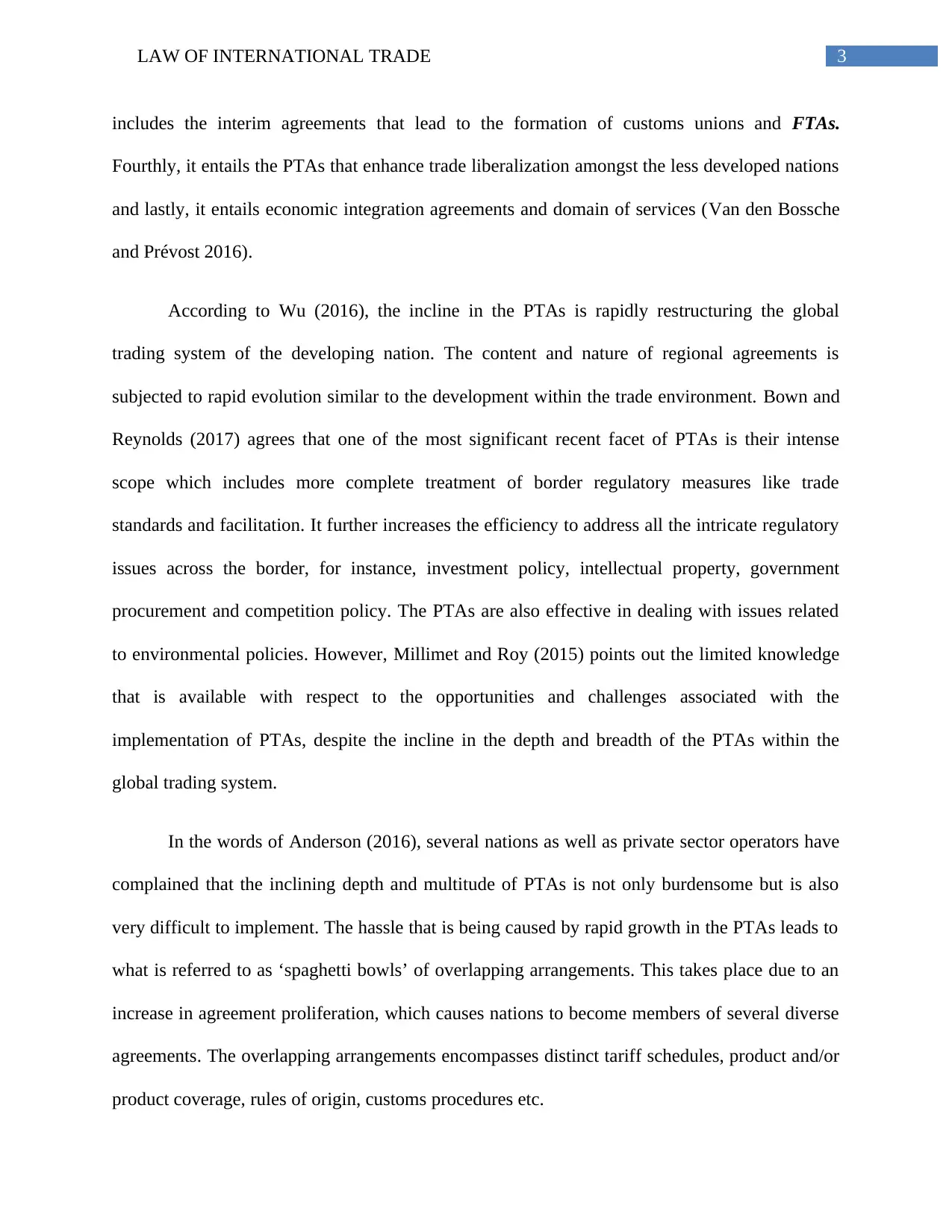
3LAW OF INTERNATIONAL TRADE
includes the interim agreements that lead to the formation of customs unions and FTAs.
Fourthly, it entails the PTAs that enhance trade liberalization amongst the less developed nations
and lastly, it entails economic integration agreements and domain of services (Van den Bossche
and Prévost 2016).
According to Wu (2016), the incline in the PTAs is rapidly restructuring the global
trading system of the developing nation. The content and nature of regional agreements is
subjected to rapid evolution similar to the development within the trade environment. Bown and
Reynolds (2017) agrees that one of the most significant recent facet of PTAs is their intense
scope which includes more complete treatment of border regulatory measures like trade
standards and facilitation. It further increases the efficiency to address all the intricate regulatory
issues across the border, for instance, investment policy, intellectual property, government
procurement and competition policy. The PTAs are also effective in dealing with issues related
to environmental policies. However, Millimet and Roy (2015) points out the limited knowledge
that is available with respect to the opportunities and challenges associated with the
implementation of PTAs, despite the incline in the depth and breadth of the PTAs within the
global trading system.
In the words of Anderson (2016), several nations as well as private sector operators have
complained that the inclining depth and multitude of PTAs is not only burdensome but is also
very difficult to implement. The hassle that is being caused by rapid growth in the PTAs leads to
what is referred to as ‘spaghetti bowls’ of overlapping arrangements. This takes place due to an
increase in agreement proliferation, which causes nations to become members of several diverse
agreements. The overlapping arrangements encompasses distinct tariff schedules, product and/or
product coverage, rules of origin, customs procedures etc.
includes the interim agreements that lead to the formation of customs unions and FTAs.
Fourthly, it entails the PTAs that enhance trade liberalization amongst the less developed nations
and lastly, it entails economic integration agreements and domain of services (Van den Bossche
and Prévost 2016).
According to Wu (2016), the incline in the PTAs is rapidly restructuring the global
trading system of the developing nation. The content and nature of regional agreements is
subjected to rapid evolution similar to the development within the trade environment. Bown and
Reynolds (2017) agrees that one of the most significant recent facet of PTAs is their intense
scope which includes more complete treatment of border regulatory measures like trade
standards and facilitation. It further increases the efficiency to address all the intricate regulatory
issues across the border, for instance, investment policy, intellectual property, government
procurement and competition policy. The PTAs are also effective in dealing with issues related
to environmental policies. However, Millimet and Roy (2015) points out the limited knowledge
that is available with respect to the opportunities and challenges associated with the
implementation of PTAs, despite the incline in the depth and breadth of the PTAs within the
global trading system.
In the words of Anderson (2016), several nations as well as private sector operators have
complained that the inclining depth and multitude of PTAs is not only burdensome but is also
very difficult to implement. The hassle that is being caused by rapid growth in the PTAs leads to
what is referred to as ‘spaghetti bowls’ of overlapping arrangements. This takes place due to an
increase in agreement proliferation, which causes nations to become members of several diverse
agreements. The overlapping arrangements encompasses distinct tariff schedules, product and/or
product coverage, rules of origin, customs procedures etc.
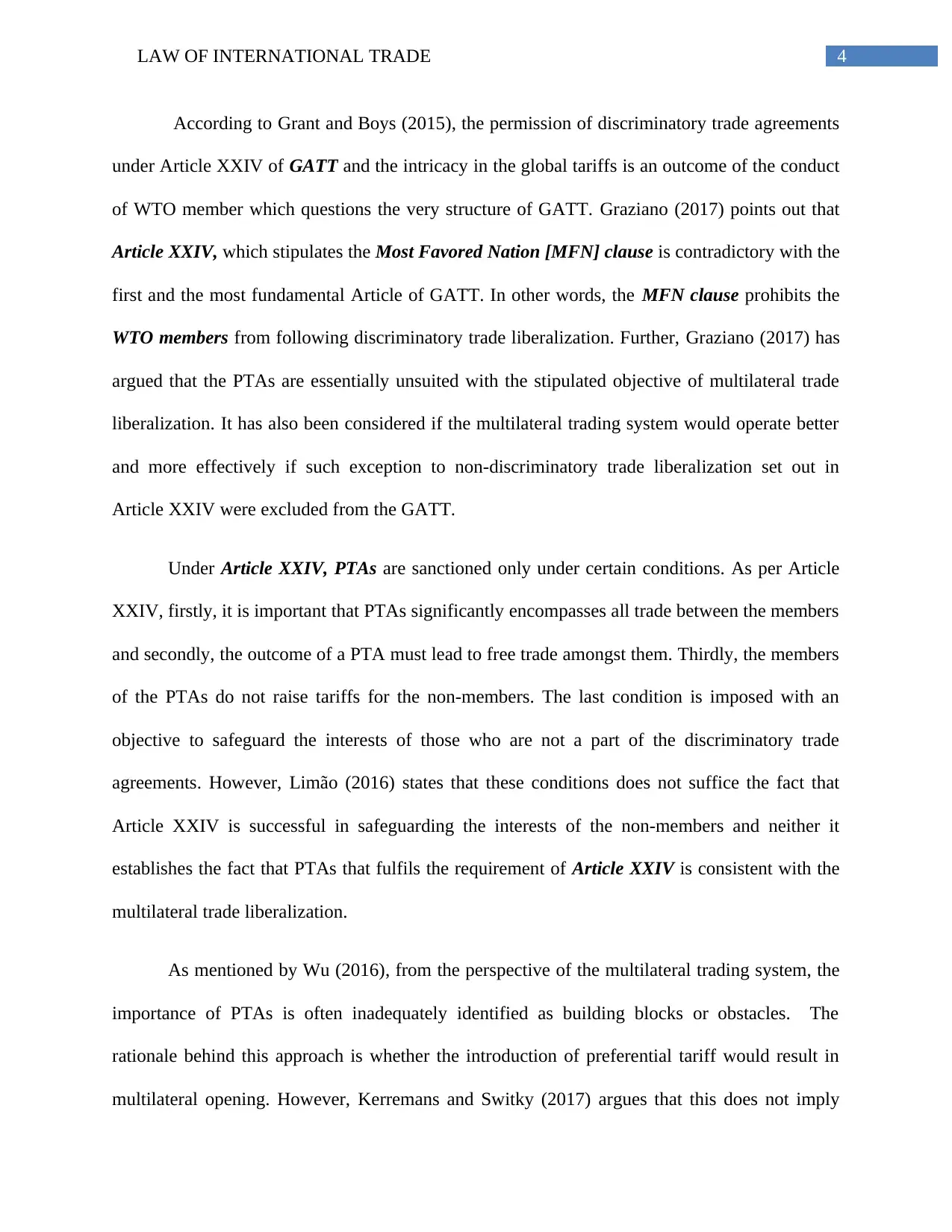
4LAW OF INTERNATIONAL TRADE
According to Grant and Boys (2015), the permission of discriminatory trade agreements
under Article XXIV of GATT and the intricacy in the global tariffs is an outcome of the conduct
of WTO member which questions the very structure of GATT. Graziano (2017) points out that
Article XXIV, which stipulates the Most Favored Nation [MFN] clause is contradictory with the
first and the most fundamental Article of GATT. In other words, the MFN clause prohibits the
WTO members from following discriminatory trade liberalization. Further, Graziano (2017) has
argued that the PTAs are essentially unsuited with the stipulated objective of multilateral trade
liberalization. It has also been considered if the multilateral trading system would operate better
and more effectively if such exception to non-discriminatory trade liberalization set out in
Article XXIV were excluded from the GATT.
Under Article XXIV, PTAs are sanctioned only under certain conditions. As per Article
XXIV, firstly, it is important that PTAs significantly encompasses all trade between the members
and secondly, the outcome of a PTA must lead to free trade amongst them. Thirdly, the members
of the PTAs do not raise tariffs for the non-members. The last condition is imposed with an
objective to safeguard the interests of those who are not a part of the discriminatory trade
agreements. However, Limão (2016) states that these conditions does not suffice the fact that
Article XXIV is successful in safeguarding the interests of the non-members and neither it
establishes the fact that PTAs that fulfils the requirement of Article XXIV is consistent with the
multilateral trade liberalization.
As mentioned by Wu (2016), from the perspective of the multilateral trading system, the
importance of PTAs is often inadequately identified as building blocks or obstacles. The
rationale behind this approach is whether the introduction of preferential tariff would result in
multilateral opening. However, Kerremans and Switky (2017) argues that this does not imply
According to Grant and Boys (2015), the permission of discriminatory trade agreements
under Article XXIV of GATT and the intricacy in the global tariffs is an outcome of the conduct
of WTO member which questions the very structure of GATT. Graziano (2017) points out that
Article XXIV, which stipulates the Most Favored Nation [MFN] clause is contradictory with the
first and the most fundamental Article of GATT. In other words, the MFN clause prohibits the
WTO members from following discriminatory trade liberalization. Further, Graziano (2017) has
argued that the PTAs are essentially unsuited with the stipulated objective of multilateral trade
liberalization. It has also been considered if the multilateral trading system would operate better
and more effectively if such exception to non-discriminatory trade liberalization set out in
Article XXIV were excluded from the GATT.
Under Article XXIV, PTAs are sanctioned only under certain conditions. As per Article
XXIV, firstly, it is important that PTAs significantly encompasses all trade between the members
and secondly, the outcome of a PTA must lead to free trade amongst them. Thirdly, the members
of the PTAs do not raise tariffs for the non-members. The last condition is imposed with an
objective to safeguard the interests of those who are not a part of the discriminatory trade
agreements. However, Limão (2016) states that these conditions does not suffice the fact that
Article XXIV is successful in safeguarding the interests of the non-members and neither it
establishes the fact that PTAs that fulfils the requirement of Article XXIV is consistent with the
multilateral trade liberalization.
As mentioned by Wu (2016), from the perspective of the multilateral trading system, the
importance of PTAs is often inadequately identified as building blocks or obstacles. The
rationale behind this approach is whether the introduction of preferential tariff would result in
multilateral opening. However, Kerremans and Switky (2017) argues that this does not imply
Secure Best Marks with AI Grader
Need help grading? Try our AI Grader for instant feedback on your assignments.
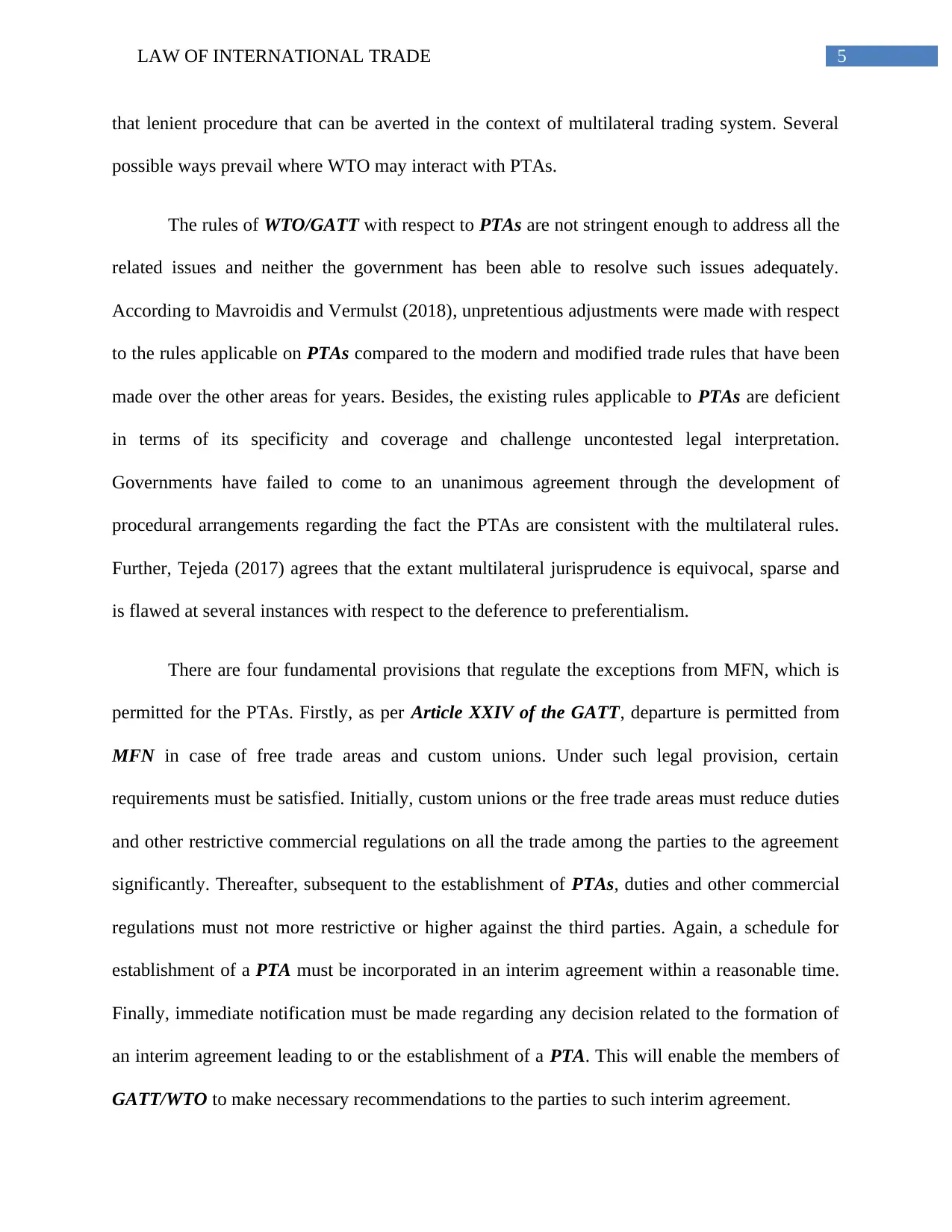
5LAW OF INTERNATIONAL TRADE
that lenient procedure that can be averted in the context of multilateral trading system. Several
possible ways prevail where WTO may interact with PTAs.
The rules of WTO/GATT with respect to PTAs are not stringent enough to address all the
related issues and neither the government has been able to resolve such issues adequately.
According to Mavroidis and Vermulst (2018), unpretentious adjustments were made with respect
to the rules applicable on PTAs compared to the modern and modified trade rules that have been
made over the other areas for years. Besides, the existing rules applicable to PTAs are deficient
in terms of its specificity and coverage and challenge uncontested legal interpretation.
Governments have failed to come to an unanimous agreement through the development of
procedural arrangements regarding the fact the PTAs are consistent with the multilateral rules.
Further, Tejeda (2017) agrees that the extant multilateral jurisprudence is equivocal, sparse and
is flawed at several instances with respect to the deference to preferentialism.
There are four fundamental provisions that regulate the exceptions from MFN, which is
permitted for the PTAs. Firstly, as per Article XXIV of the GATT, departure is permitted from
MFN in case of free trade areas and custom unions. Under such legal provision, certain
requirements must be satisfied. Initially, custom unions or the free trade areas must reduce duties
and other restrictive commercial regulations on all the trade among the parties to the agreement
significantly. Thereafter, subsequent to the establishment of PTAs, duties and other commercial
regulations must not more restrictive or higher against the third parties. Again, a schedule for
establishment of a PTA must be incorporated in an interim agreement within a reasonable time.
Finally, immediate notification must be made regarding any decision related to the formation of
an interim agreement leading to or the establishment of a PTA. This will enable the members of
GATT/WTO to make necessary recommendations to the parties to such interim agreement.
that lenient procedure that can be averted in the context of multilateral trading system. Several
possible ways prevail where WTO may interact with PTAs.
The rules of WTO/GATT with respect to PTAs are not stringent enough to address all the
related issues and neither the government has been able to resolve such issues adequately.
According to Mavroidis and Vermulst (2018), unpretentious adjustments were made with respect
to the rules applicable on PTAs compared to the modern and modified trade rules that have been
made over the other areas for years. Besides, the existing rules applicable to PTAs are deficient
in terms of its specificity and coverage and challenge uncontested legal interpretation.
Governments have failed to come to an unanimous agreement through the development of
procedural arrangements regarding the fact the PTAs are consistent with the multilateral rules.
Further, Tejeda (2017) agrees that the extant multilateral jurisprudence is equivocal, sparse and
is flawed at several instances with respect to the deference to preferentialism.
There are four fundamental provisions that regulate the exceptions from MFN, which is
permitted for the PTAs. Firstly, as per Article XXIV of the GATT, departure is permitted from
MFN in case of free trade areas and custom unions. Under such legal provision, certain
requirements must be satisfied. Initially, custom unions or the free trade areas must reduce duties
and other restrictive commercial regulations on all the trade among the parties to the agreement
significantly. Thereafter, subsequent to the establishment of PTAs, duties and other commercial
regulations must not more restrictive or higher against the third parties. Again, a schedule for
establishment of a PTA must be incorporated in an interim agreement within a reasonable time.
Finally, immediate notification must be made regarding any decision related to the formation of
an interim agreement leading to or the establishment of a PTA. This will enable the members of
GATT/WTO to make necessary recommendations to the parties to such interim agreement.
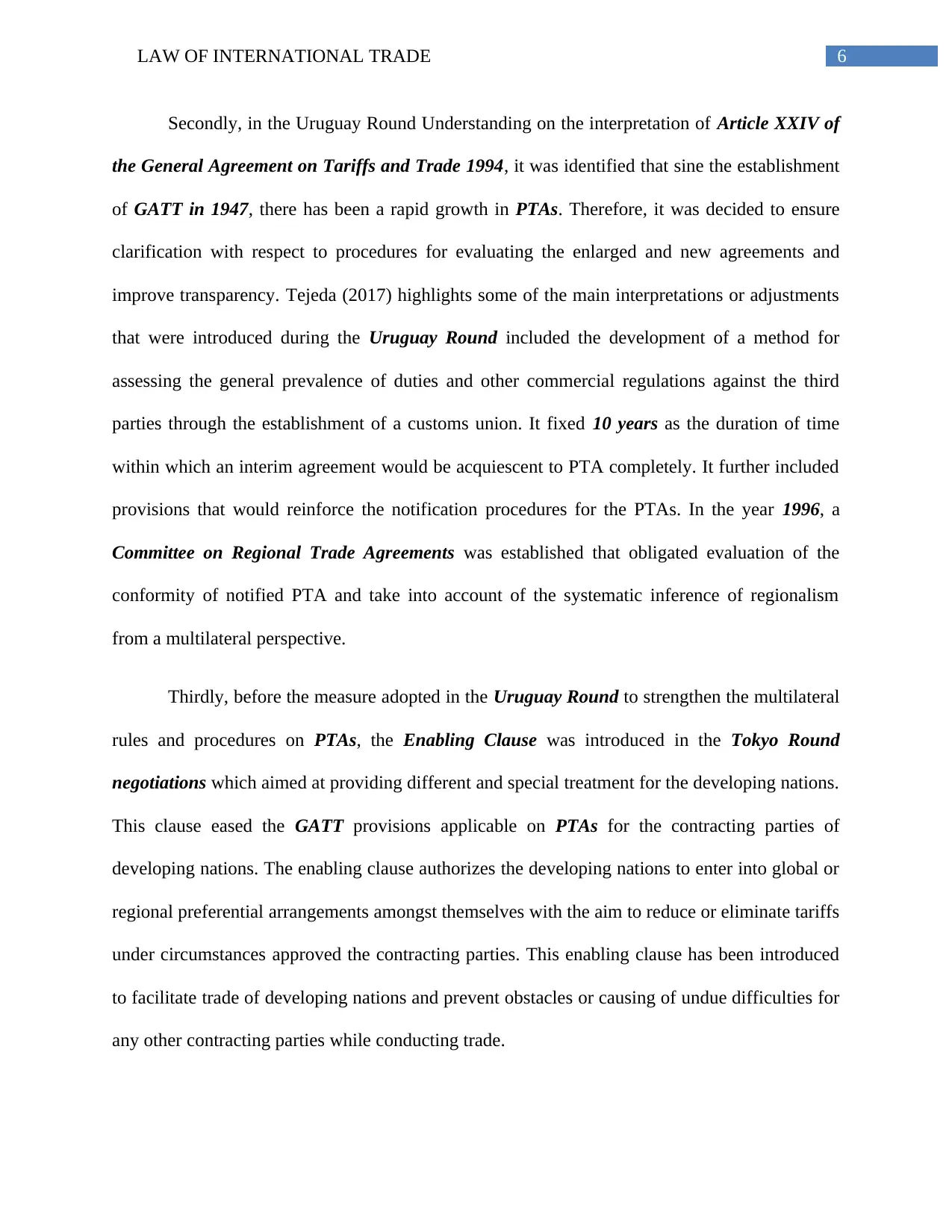
6LAW OF INTERNATIONAL TRADE
Secondly, in the Uruguay Round Understanding on the interpretation of Article XXIV of
the General Agreement on Tariffs and Trade 1994, it was identified that sine the establishment
of GATT in 1947, there has been a rapid growth in PTAs. Therefore, it was decided to ensure
clarification with respect to procedures for evaluating the enlarged and new agreements and
improve transparency. Tejeda (2017) highlights some of the main interpretations or adjustments
that were introduced during the Uruguay Round included the development of a method for
assessing the general prevalence of duties and other commercial regulations against the third
parties through the establishment of a customs union. It fixed 10 years as the duration of time
within which an interim agreement would be acquiescent to PTA completely. It further included
provisions that would reinforce the notification procedures for the PTAs. In the year 1996, a
Committee on Regional Trade Agreements was established that obligated evaluation of the
conformity of notified PTA and take into account of the systematic inference of regionalism
from a multilateral perspective.
Thirdly, before the measure adopted in the Uruguay Round to strengthen the multilateral
rules and procedures on PTAs, the Enabling Clause was introduced in the Tokyo Round
negotiations which aimed at providing different and special treatment for the developing nations.
This clause eased the GATT provisions applicable on PTAs for the contracting parties of
developing nations. The enabling clause authorizes the developing nations to enter into global or
regional preferential arrangements amongst themselves with the aim to reduce or eliminate tariffs
under circumstances approved the contracting parties. This enabling clause has been introduced
to facilitate trade of developing nations and prevent obstacles or causing of undue difficulties for
any other contracting parties while conducting trade.
Secondly, in the Uruguay Round Understanding on the interpretation of Article XXIV of
the General Agreement on Tariffs and Trade 1994, it was identified that sine the establishment
of GATT in 1947, there has been a rapid growth in PTAs. Therefore, it was decided to ensure
clarification with respect to procedures for evaluating the enlarged and new agreements and
improve transparency. Tejeda (2017) highlights some of the main interpretations or adjustments
that were introduced during the Uruguay Round included the development of a method for
assessing the general prevalence of duties and other commercial regulations against the third
parties through the establishment of a customs union. It fixed 10 years as the duration of time
within which an interim agreement would be acquiescent to PTA completely. It further included
provisions that would reinforce the notification procedures for the PTAs. In the year 1996, a
Committee on Regional Trade Agreements was established that obligated evaluation of the
conformity of notified PTA and take into account of the systematic inference of regionalism
from a multilateral perspective.
Thirdly, before the measure adopted in the Uruguay Round to strengthen the multilateral
rules and procedures on PTAs, the Enabling Clause was introduced in the Tokyo Round
negotiations which aimed at providing different and special treatment for the developing nations.
This clause eased the GATT provisions applicable on PTAs for the contracting parties of
developing nations. The enabling clause authorizes the developing nations to enter into global or
regional preferential arrangements amongst themselves with the aim to reduce or eliminate tariffs
under circumstances approved the contracting parties. This enabling clause has been introduced
to facilitate trade of developing nations and prevent obstacles or causing of undue difficulties for
any other contracting parties while conducting trade.
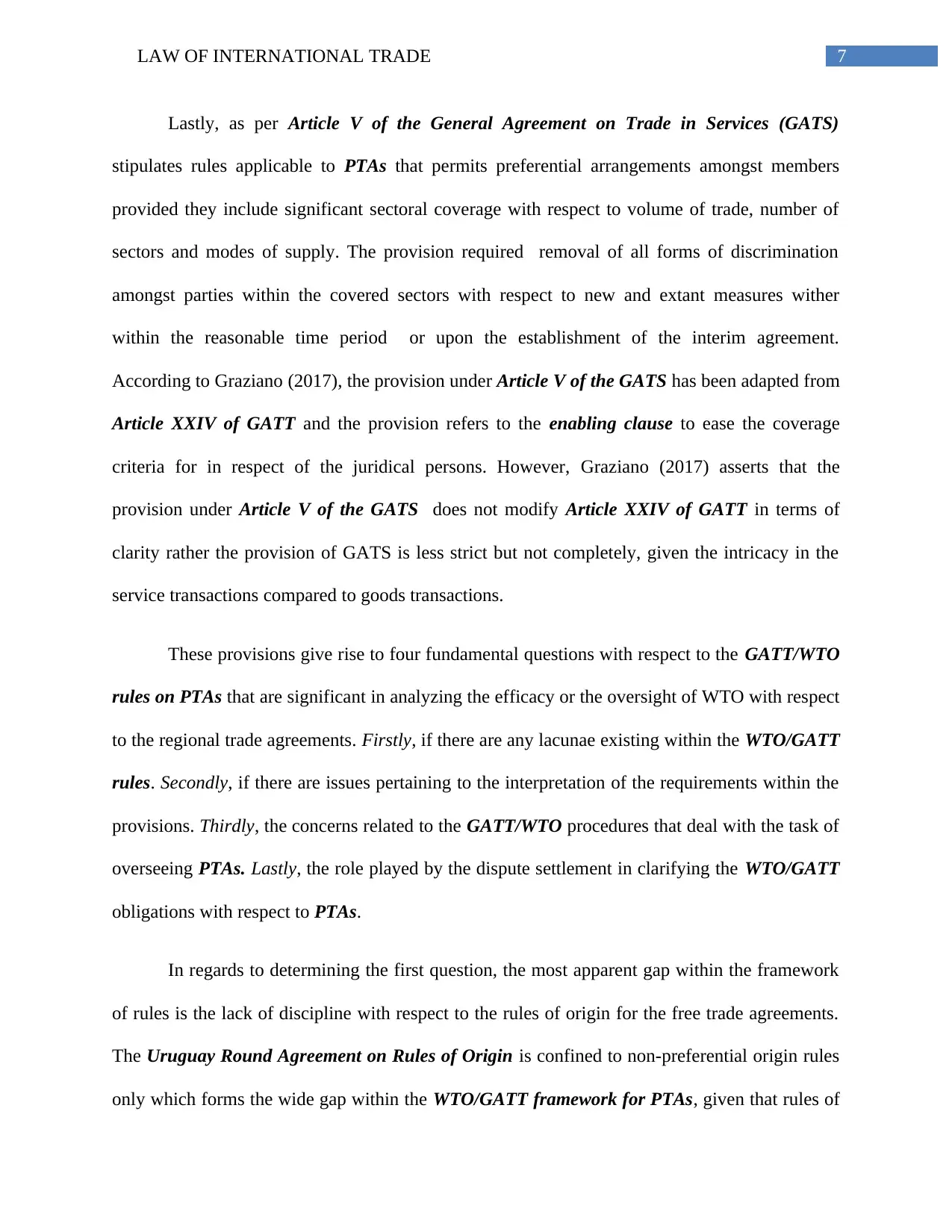
7LAW OF INTERNATIONAL TRADE
Lastly, as per Article V of the General Agreement on Trade in Services (GATS)
stipulates rules applicable to PTAs that permits preferential arrangements amongst members
provided they include significant sectoral coverage with respect to volume of trade, number of
sectors and modes of supply. The provision required removal of all forms of discrimination
amongst parties within the covered sectors with respect to new and extant measures wither
within the reasonable time period or upon the establishment of the interim agreement.
According to Graziano (2017), the provision under Article V of the GATS has been adapted from
Article XXIV of GATT and the provision refers to the enabling clause to ease the coverage
criteria for in respect of the juridical persons. However, Graziano (2017) asserts that the
provision under Article V of the GATS does not modify Article XXIV of GATT in terms of
clarity rather the provision of GATS is less strict but not completely, given the intricacy in the
service transactions compared to goods transactions.
These provisions give rise to four fundamental questions with respect to the GATT/WTO
rules on PTAs that are significant in analyzing the efficacy or the oversight of WTO with respect
to the regional trade agreements. Firstly, if there are any lacunae existing within the WTO/GATT
rules. Secondly, if there are issues pertaining to the interpretation of the requirements within the
provisions. Thirdly, the concerns related to the GATT/WTO procedures that deal with the task of
overseeing PTAs. Lastly, the role played by the dispute settlement in clarifying the WTO/GATT
obligations with respect to PTAs.
In regards to determining the first question, the most apparent gap within the framework
of rules is the lack of discipline with respect to the rules of origin for the free trade agreements.
The Uruguay Round Agreement on Rules of Origin is confined to non-preferential origin rules
only which forms the wide gap within the WTO/GATT framework for PTAs, given that rules of
Lastly, as per Article V of the General Agreement on Trade in Services (GATS)
stipulates rules applicable to PTAs that permits preferential arrangements amongst members
provided they include significant sectoral coverage with respect to volume of trade, number of
sectors and modes of supply. The provision required removal of all forms of discrimination
amongst parties within the covered sectors with respect to new and extant measures wither
within the reasonable time period or upon the establishment of the interim agreement.
According to Graziano (2017), the provision under Article V of the GATS has been adapted from
Article XXIV of GATT and the provision refers to the enabling clause to ease the coverage
criteria for in respect of the juridical persons. However, Graziano (2017) asserts that the
provision under Article V of the GATS does not modify Article XXIV of GATT in terms of
clarity rather the provision of GATS is less strict but not completely, given the intricacy in the
service transactions compared to goods transactions.
These provisions give rise to four fundamental questions with respect to the GATT/WTO
rules on PTAs that are significant in analyzing the efficacy or the oversight of WTO with respect
to the regional trade agreements. Firstly, if there are any lacunae existing within the WTO/GATT
rules. Secondly, if there are issues pertaining to the interpretation of the requirements within the
provisions. Thirdly, the concerns related to the GATT/WTO procedures that deal with the task of
overseeing PTAs. Lastly, the role played by the dispute settlement in clarifying the WTO/GATT
obligations with respect to PTAs.
In regards to determining the first question, the most apparent gap within the framework
of rules is the lack of discipline with respect to the rules of origin for the free trade agreements.
The Uruguay Round Agreement on Rules of Origin is confined to non-preferential origin rules
only which forms the wide gap within the WTO/GATT framework for PTAs, given that rules of
Paraphrase This Document
Need a fresh take? Get an instant paraphrase of this document with our AI Paraphraser
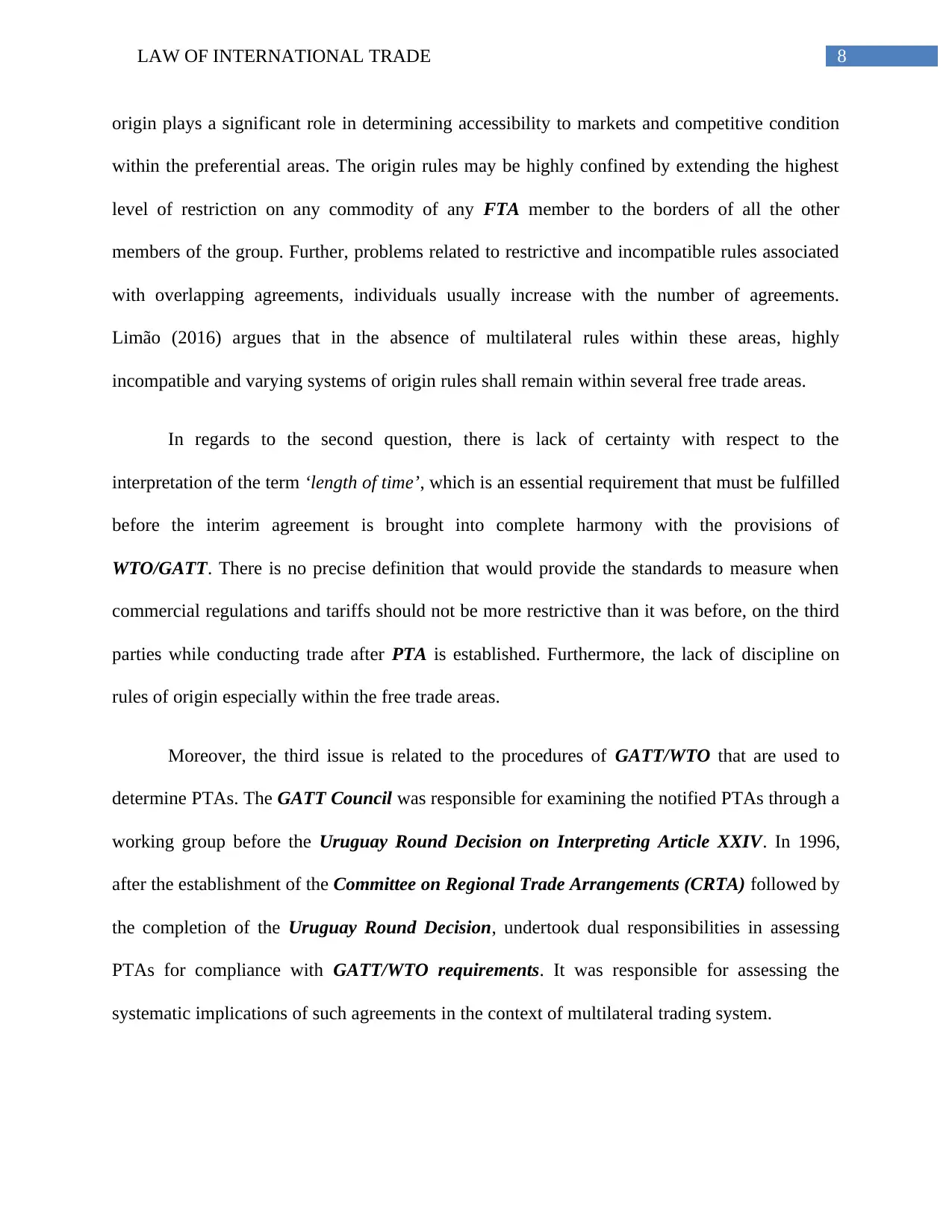
8LAW OF INTERNATIONAL TRADE
origin plays a significant role in determining accessibility to markets and competitive condition
within the preferential areas. The origin rules may be highly confined by extending the highest
level of restriction on any commodity of any FTA member to the borders of all the other
members of the group. Further, problems related to restrictive and incompatible rules associated
with overlapping agreements, individuals usually increase with the number of agreements.
Limão (2016) argues that in the absence of multilateral rules within these areas, highly
incompatible and varying systems of origin rules shall remain within several free trade areas.
In regards to the second question, there is lack of certainty with respect to the
interpretation of the term ‘length of time’, which is an essential requirement that must be fulfilled
before the interim agreement is brought into complete harmony with the provisions of
WTO/GATT. There is no precise definition that would provide the standards to measure when
commercial regulations and tariffs should not be more restrictive than it was before, on the third
parties while conducting trade after PTA is established. Furthermore, the lack of discipline on
rules of origin especially within the free trade areas.
Moreover, the third issue is related to the procedures of GATT/WTO that are used to
determine PTAs. The GATT Council was responsible for examining the notified PTAs through a
working group before the Uruguay Round Decision on Interpreting Article XXIV. In 1996,
after the establishment of the Committee on Regional Trade Arrangements (CRTA) followed by
the completion of the Uruguay Round Decision, undertook dual responsibilities in assessing
PTAs for compliance with GATT/WTO requirements. It was responsible for assessing the
systematic implications of such agreements in the context of multilateral trading system.
origin plays a significant role in determining accessibility to markets and competitive condition
within the preferential areas. The origin rules may be highly confined by extending the highest
level of restriction on any commodity of any FTA member to the borders of all the other
members of the group. Further, problems related to restrictive and incompatible rules associated
with overlapping agreements, individuals usually increase with the number of agreements.
Limão (2016) argues that in the absence of multilateral rules within these areas, highly
incompatible and varying systems of origin rules shall remain within several free trade areas.
In regards to the second question, there is lack of certainty with respect to the
interpretation of the term ‘length of time’, which is an essential requirement that must be fulfilled
before the interim agreement is brought into complete harmony with the provisions of
WTO/GATT. There is no precise definition that would provide the standards to measure when
commercial regulations and tariffs should not be more restrictive than it was before, on the third
parties while conducting trade after PTA is established. Furthermore, the lack of discipline on
rules of origin especially within the free trade areas.
Moreover, the third issue is related to the procedures of GATT/WTO that are used to
determine PTAs. The GATT Council was responsible for examining the notified PTAs through a
working group before the Uruguay Round Decision on Interpreting Article XXIV. In 1996,
after the establishment of the Committee on Regional Trade Arrangements (CRTA) followed by
the completion of the Uruguay Round Decision, undertook dual responsibilities in assessing
PTAs for compliance with GATT/WTO requirements. It was responsible for assessing the
systematic implications of such agreements in the context of multilateral trading system.
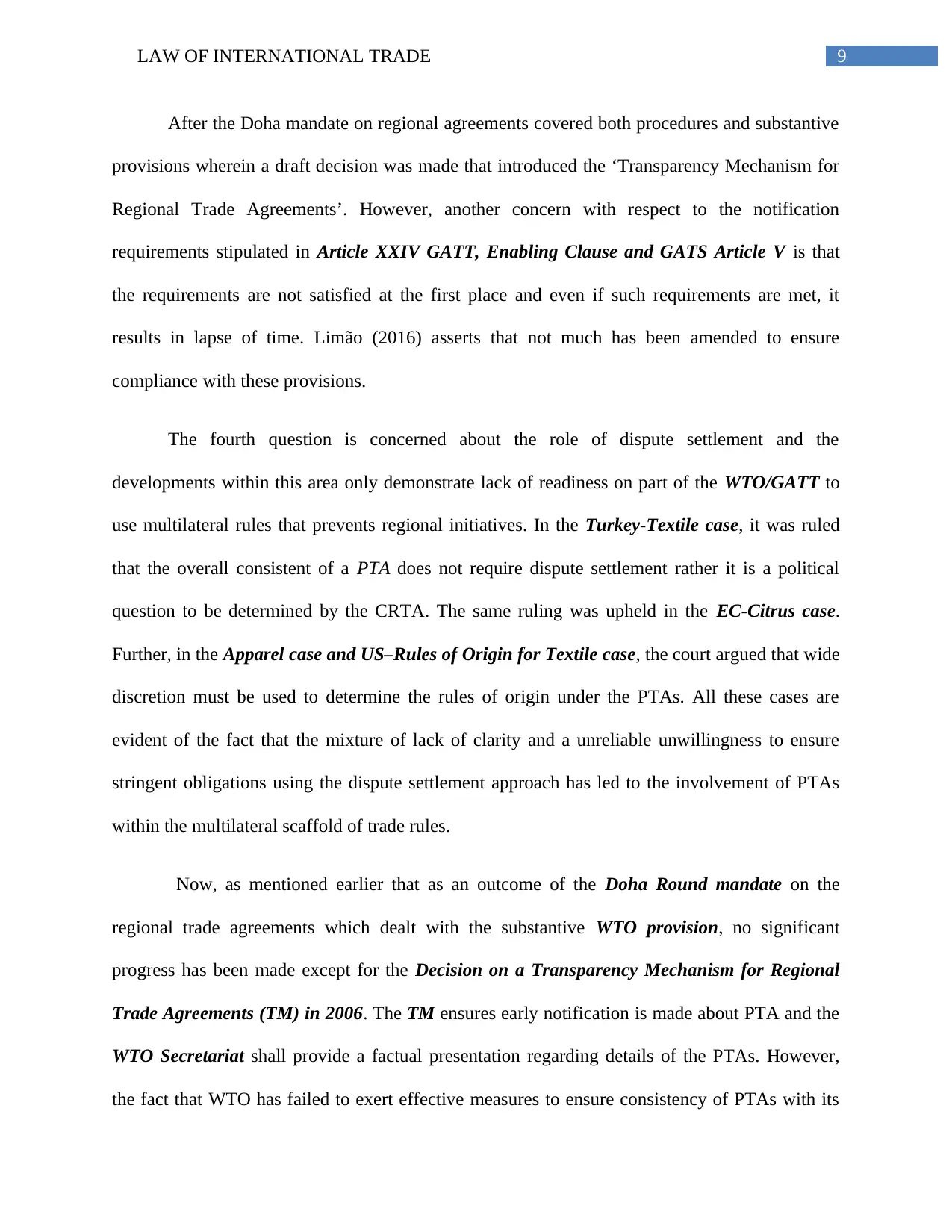
9LAW OF INTERNATIONAL TRADE
After the Doha mandate on regional agreements covered both procedures and substantive
provisions wherein a draft decision was made that introduced the ‘Transparency Mechanism for
Regional Trade Agreements’. However, another concern with respect to the notification
requirements stipulated in Article XXIV GATT, Enabling Clause and GATS Article V is that
the requirements are not satisfied at the first place and even if such requirements are met, it
results in lapse of time. Limão (2016) asserts that not much has been amended to ensure
compliance with these provisions.
The fourth question is concerned about the role of dispute settlement and the
developments within this area only demonstrate lack of readiness on part of the WTO/GATT to
use multilateral rules that prevents regional initiatives. In the Turkey-Textile case, it was ruled
that the overall consistent of a PTA does not require dispute settlement rather it is a political
question to be determined by the CRTA. The same ruling was upheld in the EC-Citrus case.
Further, in the Apparel case and US–Rules of Origin for Textile case, the court argued that wide
discretion must be used to determine the rules of origin under the PTAs. All these cases are
evident of the fact that the mixture of lack of clarity and a unreliable unwillingness to ensure
stringent obligations using the dispute settlement approach has led to the involvement of PTAs
within the multilateral scaffold of trade rules.
Now, as mentioned earlier that as an outcome of the Doha Round mandate on the
regional trade agreements which dealt with the substantive WTO provision, no significant
progress has been made except for the Decision on a Transparency Mechanism for Regional
Trade Agreements (TM) in 2006. The TM ensures early notification is made about PTA and the
WTO Secretariat shall provide a factual presentation regarding details of the PTAs. However,
the fact that WTO has failed to exert effective measures to ensure consistency of PTAs with its
After the Doha mandate on regional agreements covered both procedures and substantive
provisions wherein a draft decision was made that introduced the ‘Transparency Mechanism for
Regional Trade Agreements’. However, another concern with respect to the notification
requirements stipulated in Article XXIV GATT, Enabling Clause and GATS Article V is that
the requirements are not satisfied at the first place and even if such requirements are met, it
results in lapse of time. Limão (2016) asserts that not much has been amended to ensure
compliance with these provisions.
The fourth question is concerned about the role of dispute settlement and the
developments within this area only demonstrate lack of readiness on part of the WTO/GATT to
use multilateral rules that prevents regional initiatives. In the Turkey-Textile case, it was ruled
that the overall consistent of a PTA does not require dispute settlement rather it is a political
question to be determined by the CRTA. The same ruling was upheld in the EC-Citrus case.
Further, in the Apparel case and US–Rules of Origin for Textile case, the court argued that wide
discretion must be used to determine the rules of origin under the PTAs. All these cases are
evident of the fact that the mixture of lack of clarity and a unreliable unwillingness to ensure
stringent obligations using the dispute settlement approach has led to the involvement of PTAs
within the multilateral scaffold of trade rules.
Now, as mentioned earlier that as an outcome of the Doha Round mandate on the
regional trade agreements which dealt with the substantive WTO provision, no significant
progress has been made except for the Decision on a Transparency Mechanism for Regional
Trade Agreements (TM) in 2006. The TM ensures early notification is made about PTA and the
WTO Secretariat shall provide a factual presentation regarding details of the PTAs. However,
the fact that WTO has failed to exert effective measures to ensure consistency of PTAs with its
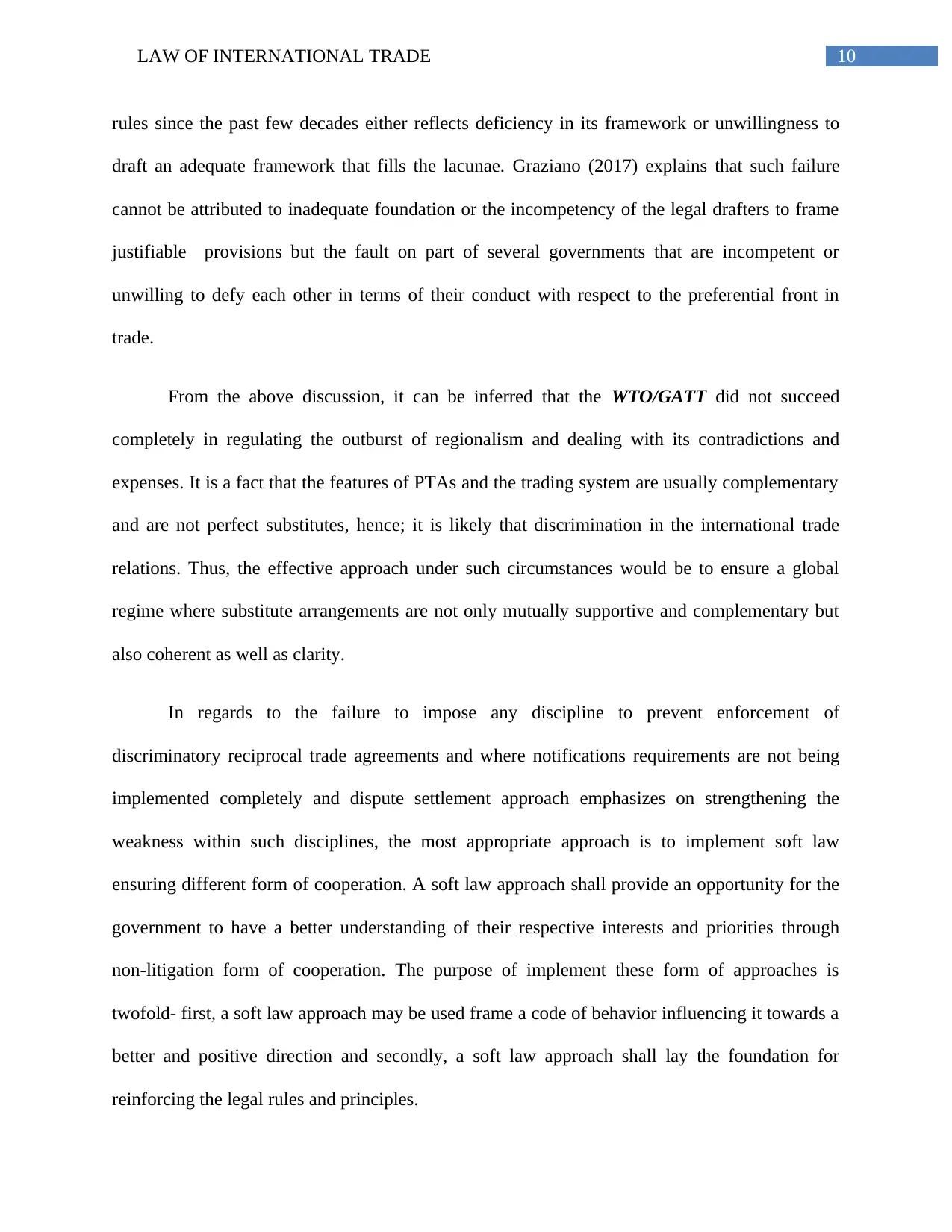
10LAW OF INTERNATIONAL TRADE
rules since the past few decades either reflects deficiency in its framework or unwillingness to
draft an adequate framework that fills the lacunae. Graziano (2017) explains that such failure
cannot be attributed to inadequate foundation or the incompetency of the legal drafters to frame
justifiable provisions but the fault on part of several governments that are incompetent or
unwilling to defy each other in terms of their conduct with respect to the preferential front in
trade.
From the above discussion, it can be inferred that the WTO/GATT did not succeed
completely in regulating the outburst of regionalism and dealing with its contradictions and
expenses. It is a fact that the features of PTAs and the trading system are usually complementary
and are not perfect substitutes, hence; it is likely that discrimination in the international trade
relations. Thus, the effective approach under such circumstances would be to ensure a global
regime where substitute arrangements are not only mutually supportive and complementary but
also coherent as well as clarity.
In regards to the failure to impose any discipline to prevent enforcement of
discriminatory reciprocal trade agreements and where notifications requirements are not being
implemented completely and dispute settlement approach emphasizes on strengthening the
weakness within such disciplines, the most appropriate approach is to implement soft law
ensuring different form of cooperation. A soft law approach shall provide an opportunity for the
government to have a better understanding of their respective interests and priorities through
non-litigation form of cooperation. The purpose of implement these form of approaches is
twofold- first, a soft law approach may be used frame a code of behavior influencing it towards a
better and positive direction and secondly, a soft law approach shall lay the foundation for
reinforcing the legal rules and principles.
rules since the past few decades either reflects deficiency in its framework or unwillingness to
draft an adequate framework that fills the lacunae. Graziano (2017) explains that such failure
cannot be attributed to inadequate foundation or the incompetency of the legal drafters to frame
justifiable provisions but the fault on part of several governments that are incompetent or
unwilling to defy each other in terms of their conduct with respect to the preferential front in
trade.
From the above discussion, it can be inferred that the WTO/GATT did not succeed
completely in regulating the outburst of regionalism and dealing with its contradictions and
expenses. It is a fact that the features of PTAs and the trading system are usually complementary
and are not perfect substitutes, hence; it is likely that discrimination in the international trade
relations. Thus, the effective approach under such circumstances would be to ensure a global
regime where substitute arrangements are not only mutually supportive and complementary but
also coherent as well as clarity.
In regards to the failure to impose any discipline to prevent enforcement of
discriminatory reciprocal trade agreements and where notifications requirements are not being
implemented completely and dispute settlement approach emphasizes on strengthening the
weakness within such disciplines, the most appropriate approach is to implement soft law
ensuring different form of cooperation. A soft law approach shall provide an opportunity for the
government to have a better understanding of their respective interests and priorities through
non-litigation form of cooperation. The purpose of implement these form of approaches is
twofold- first, a soft law approach may be used frame a code of behavior influencing it towards a
better and positive direction and secondly, a soft law approach shall lay the foundation for
reinforcing the legal rules and principles.
Secure Best Marks with AI Grader
Need help grading? Try our AI Grader for instant feedback on your assignments.
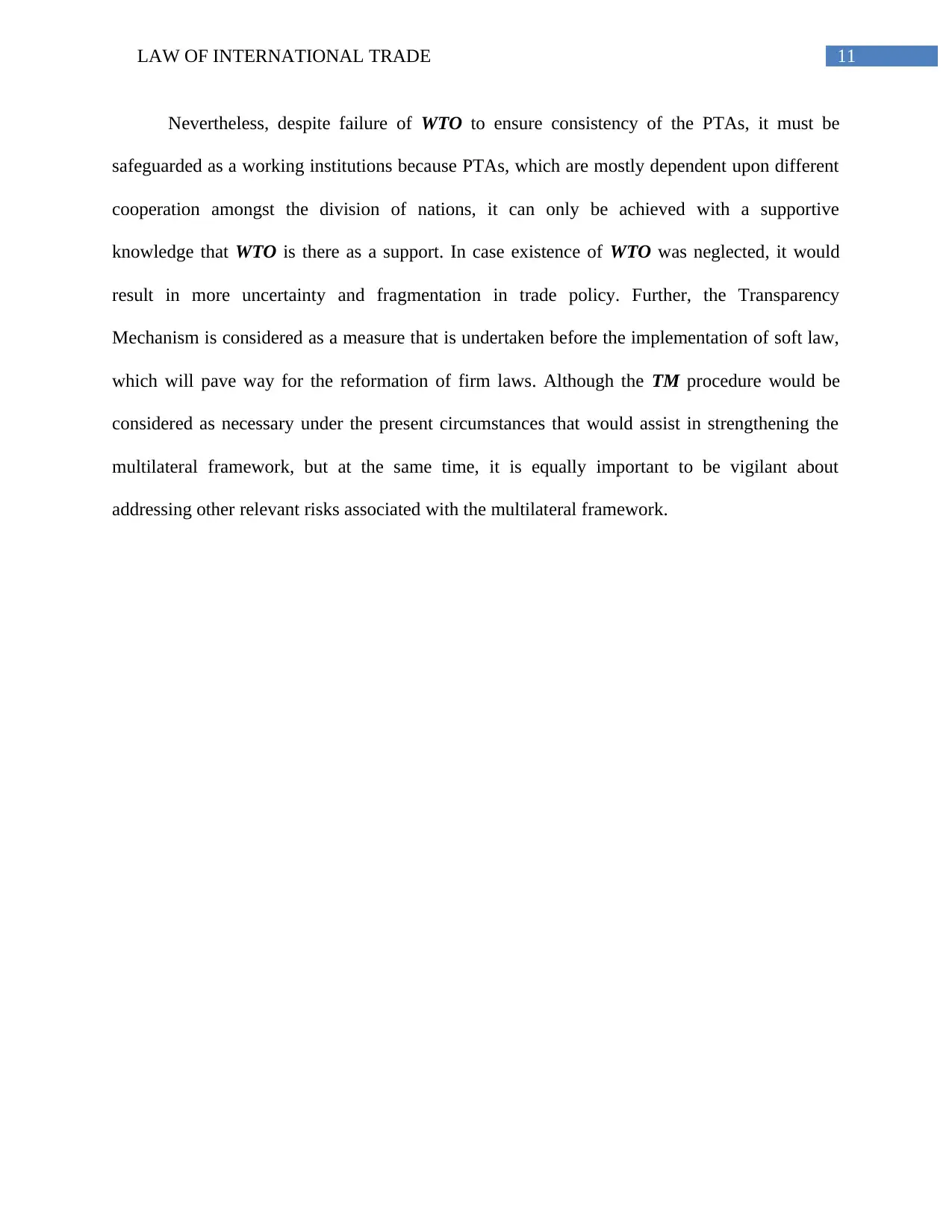
11LAW OF INTERNATIONAL TRADE
Nevertheless, despite failure of WTO to ensure consistency of the PTAs, it must be
safeguarded as a working institutions because PTAs, which are mostly dependent upon different
cooperation amongst the division of nations, it can only be achieved with a supportive
knowledge that WTO is there as a support. In case existence of WTO was neglected, it would
result in more uncertainty and fragmentation in trade policy. Further, the Transparency
Mechanism is considered as a measure that is undertaken before the implementation of soft law,
which will pave way for the reformation of firm laws. Although the TM procedure would be
considered as necessary under the present circumstances that would assist in strengthening the
multilateral framework, but at the same time, it is equally important to be vigilant about
addressing other relevant risks associated with the multilateral framework.
Nevertheless, despite failure of WTO to ensure consistency of the PTAs, it must be
safeguarded as a working institutions because PTAs, which are mostly dependent upon different
cooperation amongst the division of nations, it can only be achieved with a supportive
knowledge that WTO is there as a support. In case existence of WTO was neglected, it would
result in more uncertainty and fragmentation in trade policy. Further, the Transparency
Mechanism is considered as a measure that is undertaken before the implementation of soft law,
which will pave way for the reformation of firm laws. Although the TM procedure would be
considered as necessary under the present circumstances that would assist in strengthening the
multilateral framework, but at the same time, it is equally important to be vigilant about
addressing other relevant risks associated with the multilateral framework.
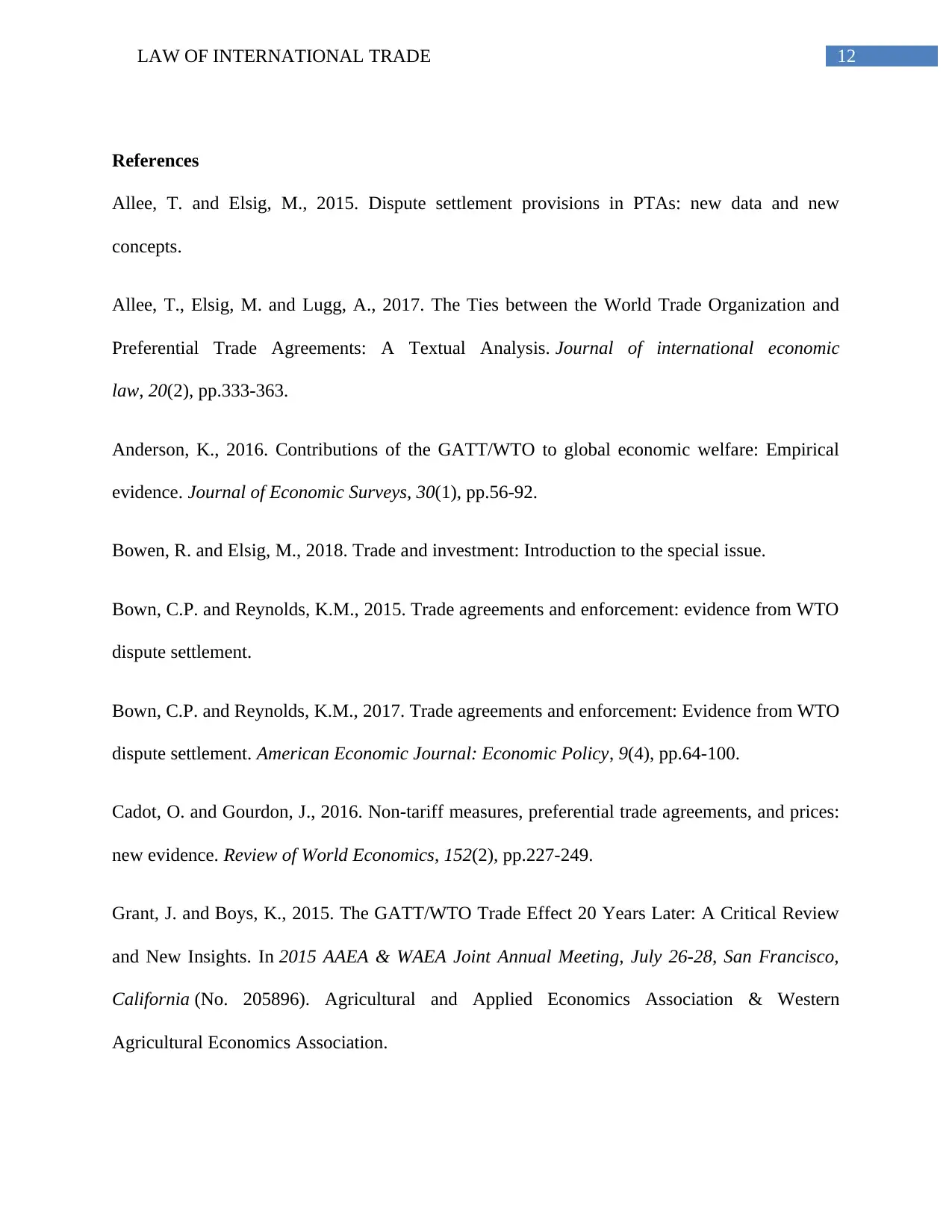
12LAW OF INTERNATIONAL TRADE
References
Allee, T. and Elsig, M., 2015. Dispute settlement provisions in PTAs: new data and new
concepts.
Allee, T., Elsig, M. and Lugg, A., 2017. The Ties between the World Trade Organization and
Preferential Trade Agreements: A Textual Analysis. Journal of international economic
law, 20(2), pp.333-363.
Anderson, K., 2016. Contributions of the GATT/WTO to global economic welfare: Empirical
evidence. Journal of Economic Surveys, 30(1), pp.56-92.
Bowen, R. and Elsig, M., 2018. Trade and investment: Introduction to the special issue.
Bown, C.P. and Reynolds, K.M., 2015. Trade agreements and enforcement: evidence from WTO
dispute settlement.
Bown, C.P. and Reynolds, K.M., 2017. Trade agreements and enforcement: Evidence from WTO
dispute settlement. American Economic Journal: Economic Policy, 9(4), pp.64-100.
Cadot, O. and Gourdon, J., 2016. Non-tariff measures, preferential trade agreements, and prices:
new evidence. Review of World Economics, 152(2), pp.227-249.
Grant, J. and Boys, K., 2015. The GATT/WTO Trade Effect 20 Years Later: A Critical Review
and New Insights. In 2015 AAEA & WAEA Joint Annual Meeting, July 26-28, San Francisco,
California (No. 205896). Agricultural and Applied Economics Association & Western
Agricultural Economics Association.
References
Allee, T. and Elsig, M., 2015. Dispute settlement provisions in PTAs: new data and new
concepts.
Allee, T., Elsig, M. and Lugg, A., 2017. The Ties between the World Trade Organization and
Preferential Trade Agreements: A Textual Analysis. Journal of international economic
law, 20(2), pp.333-363.
Anderson, K., 2016. Contributions of the GATT/WTO to global economic welfare: Empirical
evidence. Journal of Economic Surveys, 30(1), pp.56-92.
Bowen, R. and Elsig, M., 2018. Trade and investment: Introduction to the special issue.
Bown, C.P. and Reynolds, K.M., 2015. Trade agreements and enforcement: evidence from WTO
dispute settlement.
Bown, C.P. and Reynolds, K.M., 2017. Trade agreements and enforcement: Evidence from WTO
dispute settlement. American Economic Journal: Economic Policy, 9(4), pp.64-100.
Cadot, O. and Gourdon, J., 2016. Non-tariff measures, preferential trade agreements, and prices:
new evidence. Review of World Economics, 152(2), pp.227-249.
Grant, J. and Boys, K., 2015. The GATT/WTO Trade Effect 20 Years Later: A Critical Review
and New Insights. In 2015 AAEA & WAEA Joint Annual Meeting, July 26-28, San Francisco,
California (No. 205896). Agricultural and Applied Economics Association & Western
Agricultural Economics Association.
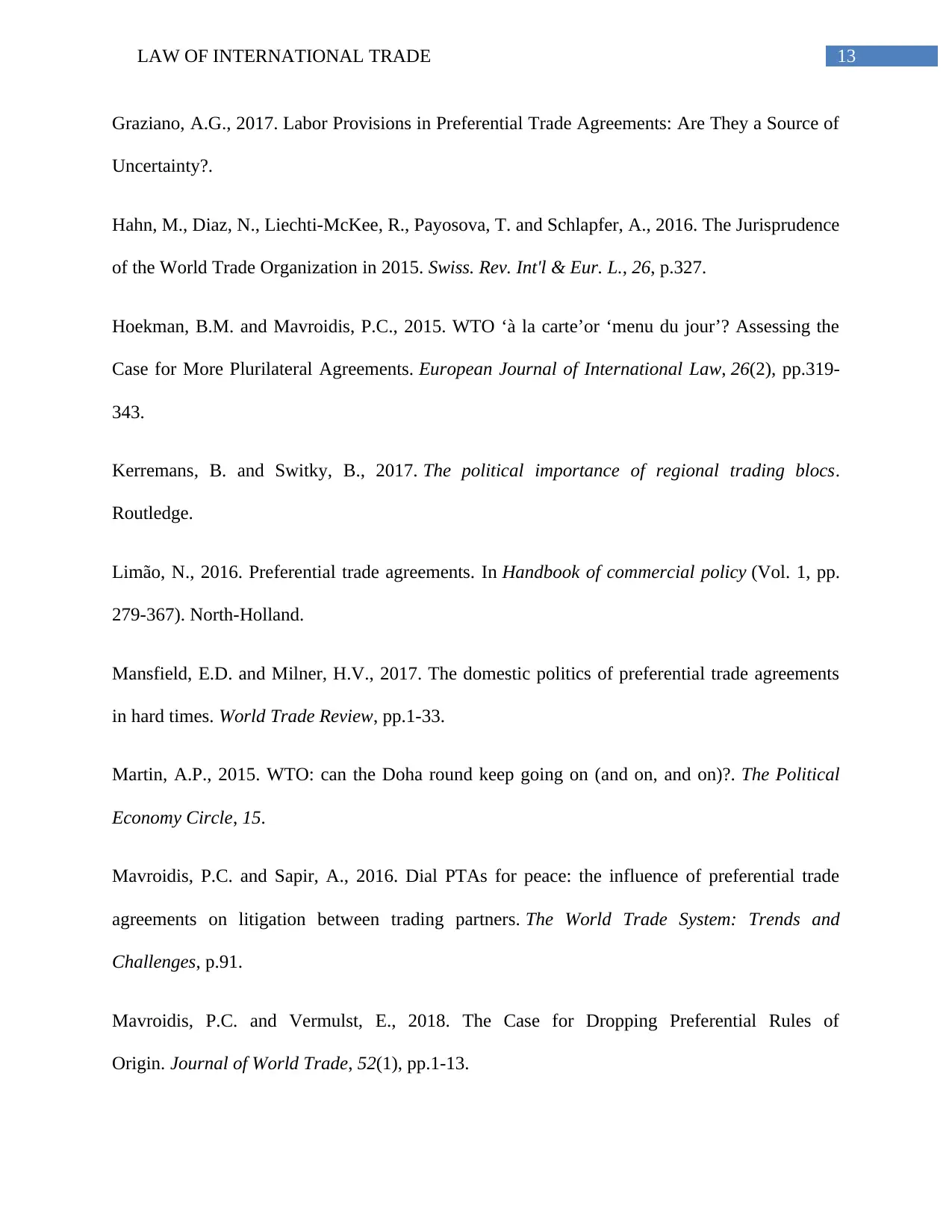
13LAW OF INTERNATIONAL TRADE
Graziano, A.G., 2017. Labor Provisions in Preferential Trade Agreements: Are They a Source of
Uncertainty?.
Hahn, M., Diaz, N., Liechti-McKee, R., Payosova, T. and Schlapfer, A., 2016. The Jurisprudence
of the World Trade Organization in 2015. Swiss. Rev. Int'l & Eur. L., 26, p.327.
Hoekman, B.M. and Mavroidis, P.C., 2015. WTO ‘à la carte’or ‘menu du jour’? Assessing the
Case for More Plurilateral Agreements. European Journal of International Law, 26(2), pp.319-
343.
Kerremans, B. and Switky, B., 2017. The political importance of regional trading blocs.
Routledge.
Limão, N., 2016. Preferential trade agreements. In Handbook of commercial policy (Vol. 1, pp.
279-367). North-Holland.
Mansfield, E.D. and Milner, H.V., 2017. The domestic politics of preferential trade agreements
in hard times. World Trade Review, pp.1-33.
Martin, A.P., 2015. WTO: can the Doha round keep going on (and on, and on)?. The Political
Economy Circle, 15.
Mavroidis, P.C. and Sapir, A., 2016. Dial PTAs for peace: the influence of preferential trade
agreements on litigation between trading partners. The World Trade System: Trends and
Challenges, p.91.
Mavroidis, P.C. and Vermulst, E., 2018. The Case for Dropping Preferential Rules of
Origin. Journal of World Trade, 52(1), pp.1-13.
Graziano, A.G., 2017. Labor Provisions in Preferential Trade Agreements: Are They a Source of
Uncertainty?.
Hahn, M., Diaz, N., Liechti-McKee, R., Payosova, T. and Schlapfer, A., 2016. The Jurisprudence
of the World Trade Organization in 2015. Swiss. Rev. Int'l & Eur. L., 26, p.327.
Hoekman, B.M. and Mavroidis, P.C., 2015. WTO ‘à la carte’or ‘menu du jour’? Assessing the
Case for More Plurilateral Agreements. European Journal of International Law, 26(2), pp.319-
343.
Kerremans, B. and Switky, B., 2017. The political importance of regional trading blocs.
Routledge.
Limão, N., 2016. Preferential trade agreements. In Handbook of commercial policy (Vol. 1, pp.
279-367). North-Holland.
Mansfield, E.D. and Milner, H.V., 2017. The domestic politics of preferential trade agreements
in hard times. World Trade Review, pp.1-33.
Martin, A.P., 2015. WTO: can the Doha round keep going on (and on, and on)?. The Political
Economy Circle, 15.
Mavroidis, P.C. and Sapir, A., 2016. Dial PTAs for peace: the influence of preferential trade
agreements on litigation between trading partners. The World Trade System: Trends and
Challenges, p.91.
Mavroidis, P.C. and Vermulst, E., 2018. The Case for Dropping Preferential Rules of
Origin. Journal of World Trade, 52(1), pp.1-13.
Paraphrase This Document
Need a fresh take? Get an instant paraphrase of this document with our AI Paraphraser
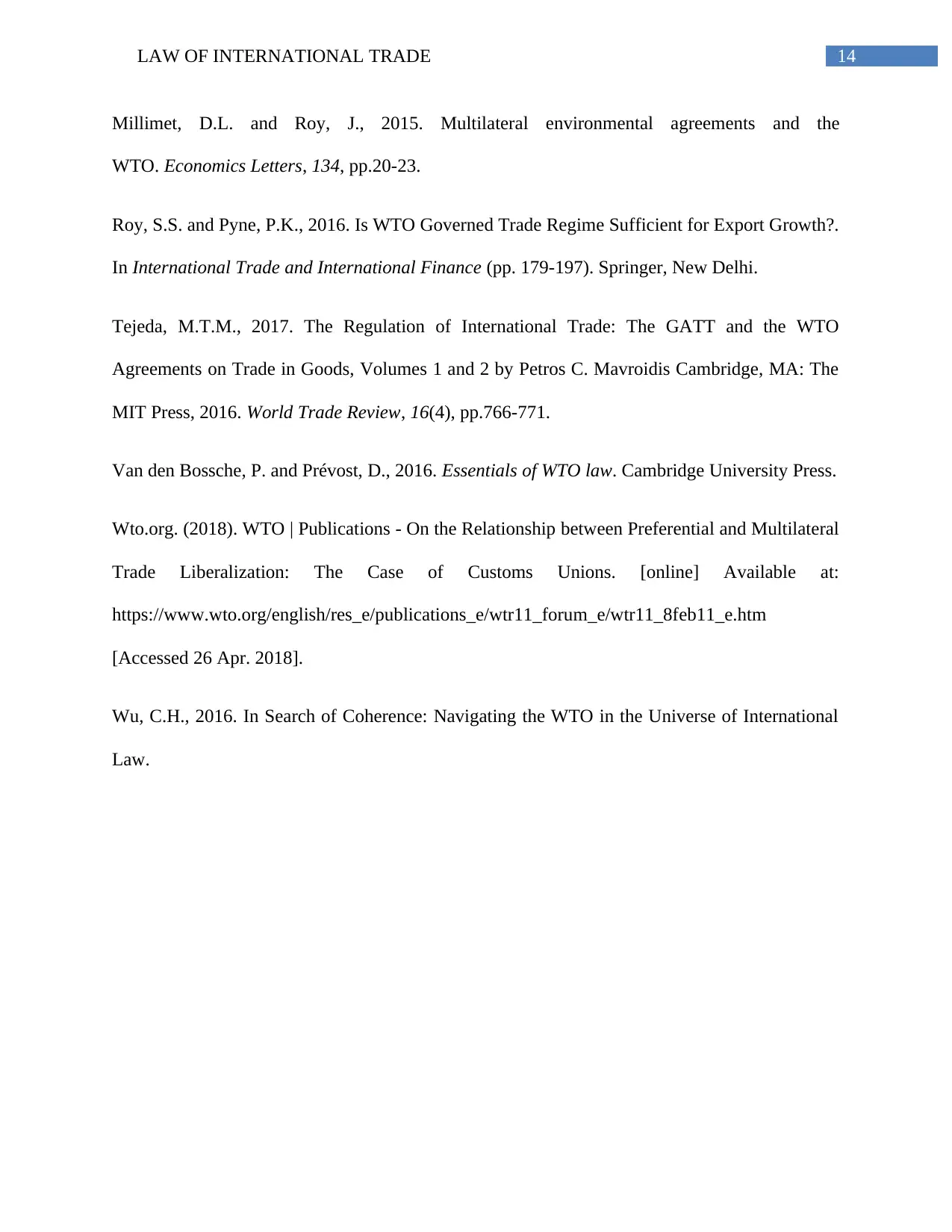
14LAW OF INTERNATIONAL TRADE
Millimet, D.L. and Roy, J., 2015. Multilateral environmental agreements and the
WTO. Economics Letters, 134, pp.20-23.
Roy, S.S. and Pyne, P.K., 2016. Is WTO Governed Trade Regime Sufficient for Export Growth?.
In International Trade and International Finance (pp. 179-197). Springer, New Delhi.
Tejeda, M.T.M., 2017. The Regulation of International Trade: The GATT and the WTO
Agreements on Trade in Goods, Volumes 1 and 2 by Petros C. Mavroidis Cambridge, MA: The
MIT Press, 2016. World Trade Review, 16(4), pp.766-771.
Van den Bossche, P. and Prévost, D., 2016. Essentials of WTO law. Cambridge University Press.
Wto.org. (2018). WTO | Publications - On the Relationship between Preferential and Multilateral
Trade Liberalization: The Case of Customs Unions. [online] Available at:
https://www.wto.org/english/res_e/publications_e/wtr11_forum_e/wtr11_8feb11_e.htm
[Accessed 26 Apr. 2018].
Wu, C.H., 2016. In Search of Coherence: Navigating the WTO in the Universe of International
Law.
Millimet, D.L. and Roy, J., 2015. Multilateral environmental agreements and the
WTO. Economics Letters, 134, pp.20-23.
Roy, S.S. and Pyne, P.K., 2016. Is WTO Governed Trade Regime Sufficient for Export Growth?.
In International Trade and International Finance (pp. 179-197). Springer, New Delhi.
Tejeda, M.T.M., 2017. The Regulation of International Trade: The GATT and the WTO
Agreements on Trade in Goods, Volumes 1 and 2 by Petros C. Mavroidis Cambridge, MA: The
MIT Press, 2016. World Trade Review, 16(4), pp.766-771.
Van den Bossche, P. and Prévost, D., 2016. Essentials of WTO law. Cambridge University Press.
Wto.org. (2018). WTO | Publications - On the Relationship between Preferential and Multilateral
Trade Liberalization: The Case of Customs Unions. [online] Available at:
https://www.wto.org/english/res_e/publications_e/wtr11_forum_e/wtr11_8feb11_e.htm
[Accessed 26 Apr. 2018].
Wu, C.H., 2016. In Search of Coherence: Navigating the WTO in the Universe of International
Law.
1 out of 14
Related Documents
Your All-in-One AI-Powered Toolkit for Academic Success.
+13062052269
info@desklib.com
Available 24*7 on WhatsApp / Email
![[object Object]](/_next/static/media/star-bottom.7253800d.svg)
Unlock your academic potential
© 2024 | Zucol Services PVT LTD | All rights reserved.





